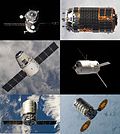 Dragon C108.3 approaching the ISS | |
| Names | SpX-18 |
|---|---|
| Mission type | ISS resupply |
| Operator | SpaceX |
| COSPAR ID | 2019-044A |
| SATCAT no. | 44446 |
| Mission duration | 32 days, 22 hours, 19 minutes |
| Spacecraft properties | |
| Spacecraft | Dragon 1 C108 |
| Spacecraft type | Dragon 1 |
| Manufacturer | SpaceX |
| Dry mass | 4,200 kg (9,300 lb) |
| Dimensions | Height: 6.1 m (20 ft) Diameter: 3.7 m (12 ft) |
| Start of mission | |
| Launch date | 25 July 2019 22:01 UTC [1] |
| Rocket | Falcon 9 Block 5 B1056-2 |
| Launch site | Cape Canaveral, SLC-40 |
| End of mission | |
| Disposal | Recovered |
| Landing date | 27 August 2019 20:20 UTC [2] |
| Landing site | Pacific Ocean off Baja California |
| Orbital parameters | |
| Reference system | Geocentric |
| Regime | Low Earth |
| Inclination | 51.6° |
| Berthing at ISS | |
| Berthing port | Harmony nadir |
| RMS capture | 27 July 13:11 UTC [3] |
| Berthing date | 27 July 2019 16:01 UTC [4] |
| Unberthing date | 27 August 2019 12:25 UTC [5] |
| RMS release | 27 August 2019 14:59 UTC [5] |
| Time berthed | 30 days, 20 hours, 24 minutes |
 NASA SpX-18 mission patch | |
SpaceX CRS-18, also known as SpX-18, was SpaceX's 18th flight to the International Space Station under the Commercial Resupply Services program for NASA. It was launched on 25 July 2019 aboard a Falcon 9 rocket. [6] [7]
Contents
The same Dragon capsule has previously flown to the ISS in April 2015 and December 2017. [8] This was the first time a capsule was used for a third flight.






